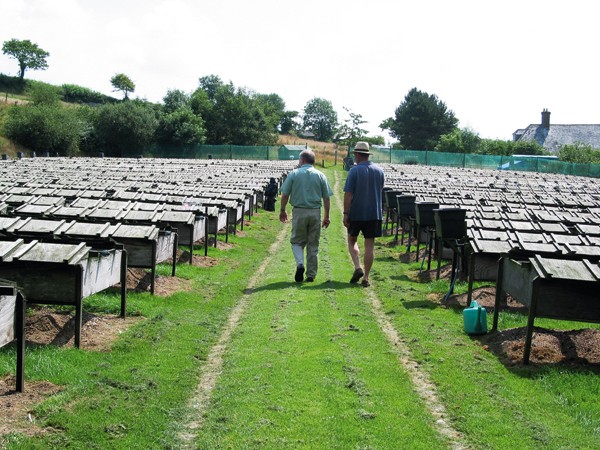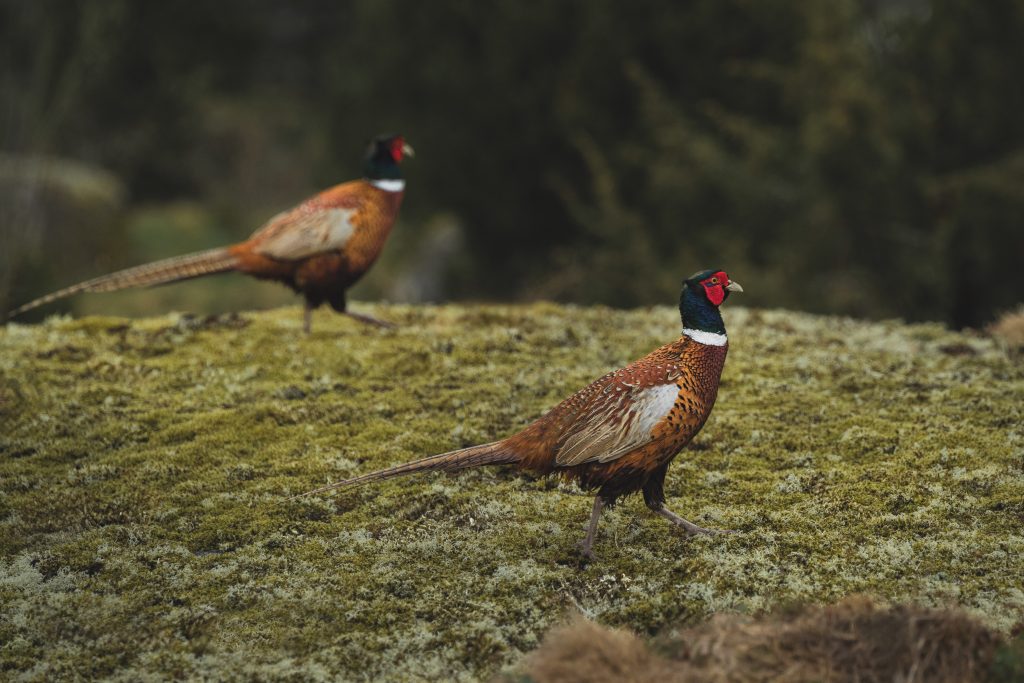Win CENS ProFlex DX5 earplugs worth £1,149 – enter here
DEFRA kicks off a cage fight
A ban on using raised cages for gamebird egg production is in the frame. Alastair Balmain investigates a topic that has split the UK's shooting bodies

Two days ago DEFRAs public consultation into the draft Code of Practice on the Welfare of Gamebirds Reared for Sporting Purposes closed. This code, when it is introduced in April, will control the working practices of all gamerearers in England and will be used to inform similar codes in Scotland and Wales its an important document for shooters.
The most contentious topic within the draft code is the proposal to ban the use of raised laying units cages to produce gamebirds eggs. By DEFRAs estimate, only six to 10 gamefarms in the UK use these systems to produce pheasant eggs. Their use overseas is far more widespread. Supporters argue that raised laying units produce cleaner eggs and are more efficient than traditional grass-based systems, yet traditional systems are more widely used by UK gamefarmers to produce pheasant eggs. In contrast, Englands 70 or so partridge producers invariably house breeding partridge pairs in small raised cages, known as partridge pair boxes.
Despite many years of wrangling on this subject and evidence from interested parties, DEFRA sidestepped a definitive decision on the use of cages when it published the draft code last November. Instead, the department gave the gamefarming industry a choice of three options to include in the final code rather than an actual decision. Under the first option, the new code would allow the use of so-called barren cages. These un-enriched cages do not include much apart from a wire mesh floor raised off the ground and a bit of shelter. The second option would allow the use of enriched units, ones which would enable pheasants and partridges to express natural behaviours through the inclusion of such items as perches, shelters, some solid flooring to stand on and abrasive materials to wear claws on and sufficient space per bird. Under the final option, however, DEFRAs new code would prohibit the use of cages entirely. Worryingly, the Game FarmersAssociation (GFA) and others are adamant that would ban partridge boxes.
The subject is an emotive one. Should gamebirds be confined in raised cages for the purpose of producing our sport? Breeding partridges have to be housed in pairs and that means an enclosure of some sort. Equally, if you import eggs or poults from overseas, it is likely that these have their origins in some sort of cage rather than on a grass-based system. The concern of many in the gamefarming and shooting sector is that should DEFRA decide on a total ban on cages in England, it will effectively force gameshooters to rely heavily on imports of eggs and poults produced under lower welfare standards. Shooters would also become more vulnerable to import bans, for example due to avian flu.
Importantly, the independent Farm Animal Welfare Council (FAWC) published an opinion on the subject of gamefarming at DEFRAs behest in November 2008. FAWCs opinion was adamant: barren cages are unacceptable. It did not call for a total ban on all cages, however. Instead, it stated clearly: It is possible that with research on space and environmental enrichment, suitable accommodation to house a single cock pheasant and a harem of hen pheasants might be developed to meet the physical and behavioural needs of the birds. DEFRAs own independent advisor, then, has categorically not called for the complete prohibition of cages.
The GFA has suggested that it is prepared to challenge by judicial review the implementation of a ban and would seek compensation running to tens of millions of pounds for the egg producers affected. It is adamant that a complete prohibition on all types of cages would be genuinely catastrophic for shooting in the UK and argues that enriched cages should be allowed in order to save domestic partridge rearing and to raise the use of cages to an acceptable welfare level for pheasants. It supports the option to allow enriched cages, a view shared by the Game & Wildlife Conservation Trust, the Countryside Alliance, the National Gamekeepers Organisation, the Country Land & Business Association and the National Farmers Union.
BASC supports a ban
Tellingly, the cause of much of the controversy surrounding cages lies not in their existence, but in the fact that, in common with shootings opponents, the British Association for Shooting and Conservation (BASC) is wholeheartedly set against their use. This position was arrived at after a film made by the animal rights group Animal Aid was televised in late 2004. Following secret filming at UK gamefarms, Assault and battery purported to show the horrific conditions gamebirds endure in barren cages. BASC was quick in its public condemnation of those gamefarmers using them. The association declared that cages were incompatible with its values and with the future of gameshooting. It is not opposed to raised laying units per se, but argues that the minimum space requirement, in its opinion, is one square meter per pheasant and that stocking density is then dictated by the size of the pen. BASCs critics contend that, at the space requirements it proposes, cages would be too big to raise off the ground, but that the same space requirements in a ground-based system would lead to a build-up of mud and faeces in the unit.
BASC has stuck to its principled position since 2004. Several days ago, BASCs director of communications Christopher Graffius lobbied MPs from all parties seeking their support for a parliamentary Early Day Motion EDM No 507. This motion, tabled by Labour MP Martin Salter, calls for a complete ban on the use of battery cages to produce gamebirds eggs whether enriched or not. It does not mention any desire to see cages enriched to a condition acceptable by the industry or DEFRA. BASC also called on MPs to lobby the DEFRA minister responsible for the code, Jim Fitzpatrick, directly for a ban. So far the EDM has attracted more than 100 signatories, mostly Labour MPs. Many will stand down at the election, just days after the codes introduction. Following this lobbying, the League Against Cruel Sports crowingly described BASC as surprising allies.
Many shooters agree with BASC on its view of cages and many shooters may not be aware of the origins of their birds. Whatever the case, there is a serious lack of consensus in the shooting industry on the subject. In seeking a ban on the use of cages, BASC has for many years defiantly set itself against others in the shooting industry. BASCs Simon Clarke last week told Shooting Times: BASC recognises that there are those who strenuously oppose change, especially those with vested interests, and they will make doom-laden predictions, allegations of bad faith and whip up conspiracies, but the truth is that BASC has never found fault with traditional partridge boxes and is campaigning for a minimum space provision of one square metre per laying pheasant prescribed in the code.
He added: BASC is working openly with the essential long-term interests of shooting in mind and does not settle for a business as usual’ outcome represented by Option 2 in the consultation. The consultation explicitly seeks views on how a cage should be defined. BASC believes that a cage for laying pheasants is one that provides less than one square metre per bird and traditional partridge boxes are to be excluded. Nobody in Government has
proposed the banning of any traditional system of gamerearing. In BASCs view, DEFRA does not want to bring about a situation where the UK imports more eggs or birds. That being so, supporting Option 3 to ban all cages makes complete sense. BASC has received no assurance from DEFRA that partridge pair boxes would not be caught up by a ban under Option 3 but DEFRA has already stated clearly in its impact assessment, signed off by Jim Fitzpatrick, that traditional partridge producers would be affected.
Severe criticism
In seeking to be a progressive shooting organisation, and not strenuously opposed to change, BASC has attracted severe criticism. Tim Bonner, spokesman for the Countryside Alliance, told Shooting Times: It is a matter of great concern that the agreed position of the majority of shooting organisations and the Governments welfare advisors, FAWC, is being undermined in this way.
He added: We understand that some people have concerns about certain types of laying system but that is no excuse for ignoring the evidence and lobbying for measures that would have severe consequences for gamefarming and thousands of shoots. Have no doubt that a total ban on cage systems would end partridge egg production in the UK. The suggestion that the code can differentiate between different species in similar systems is simply illogical. Option 3 and EDM No 507 are unconditional and BASCs request that MPs support them makes no mention of exemptions or definitions, just of a ban on all cage systems.
It is rare for shooting associations to criticise each other so harshly in public, but so serious is the GFAs view on this situation, as part of its official response to the Governments consultation on the draft code last Friday it sent the following to DEFRA: We are aware that a complex alternative to Options 1, 2, and 3 has lately been proposed by BASC, including attempts to define cages, specifying space allowances and requiring breeding partridges to be kept in large flock pens outside the laying period. Experience has shown that the last of these would cause serious welfare problems and uncontrolled aggression, particularly between cock birds. BASC is not the representative body for gamefarming, it lacks practical expertise in this area and its proposals have no evidential base. Nor have they ever been tested. Space allowances were not recommended by FAWC or by the DEFRA Working Group [which advised on the codes content] so BASCs proposals cannot resolve this issue.
The subject of cages seems finally to have come to a head.
In a matter ofweeks, DEFRA will be forced to make a decision on whether to allow their usein England or to ban them. If BASCs analysis is correct, the future of partridge pair boxes is safe and raised laying units of a high enough standard for pheasants will turn out to be acceptable. If the analysis of others is correct, however, then BASC will have lobbied for a total ban and next shooting season all partridges really will be Frenchmen.
Related Articles
Get the latest news delivered direct to your door
Subscribe to Shooting Times & Country
Discover the ultimate companion for field sports enthusiasts with Shooting Times & Country Magazine, the UK’s leading weekly publication that has been at the forefront of shooting culture since 1882. Subscribers gain access to expert tips, comprehensive gear reviews, seasonal advice and a vibrant community of like-minded shooters.
Save on shop price when you subscribe with weekly issues featuring in-depth articles on gundog training, exclusive member offers and access to the digital back issue library. A Shooting Times & Country subscription is more than a magazine, don’t just read about the countryside; immerse yourself in its most authoritative and engaging publication.







